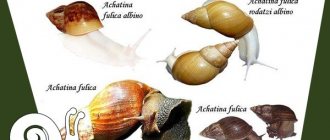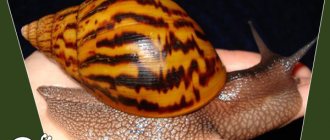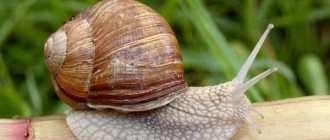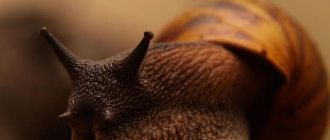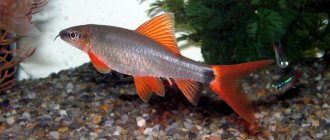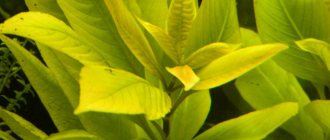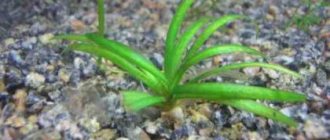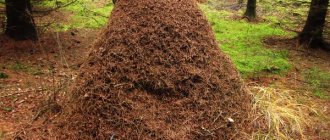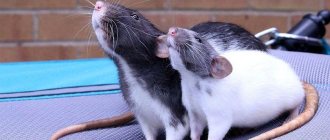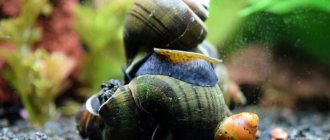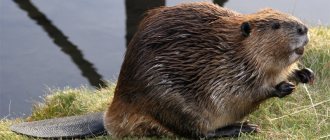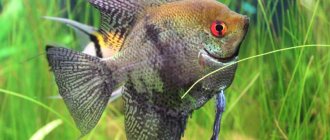Achatina Reticulata is a terrestrial mollusk that is very popular among snail breeders. Today, Achatina reticulata is one of the three unpretentious snails for keeping at home.
Firstly, they grow quickly, secondly, they are inexpensive, and thirdly, they are sociable and unpretentious animals. It is widely used in cosmetology, medicine and cooking.
Achatina Reticulata is sometimes called Achatina reticulata.
The snail received this name because of the color of its shell; brown spots, stripes and dots form an intricate mesh pattern on the light background of the shell.
Description of Achatina reticulum
The snail lives in countries with a tropical climate. In nature it grows up to 20 cm and weighs about 700 grams. The shell of the reticulum is ribbed, with a brown reticulate pattern consisting of dots and stripes. The apex and columella are white.
Achatina's body color varies from beige to dark brown. Achatina reticulata differs from other Achatina species in its rapid growth; by five months, its size can reach 15-16 cm in length. It is believed that active growth of the reticulum stops at 9 months, when the snail reaches puberty.
Cohabitation of different species
Different types of Achatina snails can coexist in one aquarium. But the editors of axatina.ru recommend that you familiarize yourself with the table of their coexistence, because some species of Achatina cannot coexist together. The table shows only the most popular types of Achatina snails. We did not find information about the coexistence of other Achatina species.
Please rate this article:
Where does Achatina Reticulata live?
Achatina reticulata is native to the tropical forests of Africa - Tanzania, Kenya and Zanzibar. In 1992, on the sand of African forests, biologist Georg Gassner found 8 reticulated Achatina, which later became the “ancestors” of domesticated snails. The reticulated Achatina is an African guest, which in Europe is kept only at home; due to climatic conditions, its survival in nature is impossible.
Habitat
This genus began its existence on the coast of East Africa, where the climate is characterized by high temperature and humidity. Now wild snails have moved to Central Africa, as well as to southern Asia. In Japan and Brazil you can still find farms where Achatina is mined. In Europe and America, giant snails are found as pets.
The type of terrain and relief does not matter for the mollusk. Giant snails can be found everywhere where there is a relatively warm climate and high humidity.
At temperatures above +10 °C, the snail becomes active and becomes an agricultural pest. If it is too cold, the animal hibernates.
Photo gallery of the Achatina snail:
Subspecies Achatina reticulata
Achatina reticulata differs in three degrees of body color. Reticulata crosses only within its own species, maintaining its purity.
Achatina reticulata Albino body
Characterized by a milky white leg color and a standard shell color, it is one of the favorite representatives among snail breeders. The optimal temperature for keeping albinos is 28-29 degrees. It is believed that they could not survive in nature, they are too noticeable. Previously, it was believed that albinos often get sick, cannot tolerate transportation at all, and do not grow well at home, but this is a myth. Read about keeping albinos here.
Achatina reticulata Light head
It is characterized by a standard shell color and a light body color of the snail. Body color varies from cream to dark beige. The head of the mollusk is most often slightly darker than the color of the leg of the reticulum.
See more similar articles:
Is it possible to give snails milk?
What grass can be given to Achatina and stored for the winter?
Back Forward 1 of 36
Achatina reticulata Dark head
It is characterized by the dark color of the head and sometimes the body of the snail. The color of the leg varies from dark brown to black. However, the head of the reticulum is always darker than the body. Snail breeders often purchase them for their collection.
The color and mesh pattern on the ribbed shell of Achatina reticulata is always the same, regardless of its variety.
The shells of baby Achatina reticulata have characteristic cherry-colored stripes and dots.
What and how to contain Achatina Reticulata
At home, retics are kept in a terrarium, rectangular aquarium or food container with a ventilated lid. The volume of the snail's home should be at least 20 liters. Soil is placed at the bottom of the terrarium. For example, coconut substrate, dry leaves of oak, birch or moss. There should be about 1/3 of the aquarium soil; it is necessary to maintain optimal humidity in the terrarium (70-80%), snail sleep and egg incubation. This article will help you choose soil.
Snails grow faster in high humidity and temperature.
Equip the snail's home with a shallow bowl of warm water, and irrigate the walls of the terrarium with boiled water once a day. Place dry branches and driftwood in a container; shellfish love to rest on them. Achatina reticulata feels great at a temperature of 26-28 degrees; an incandescent lamp or a thermal cord will help you maintain this temperature.
Cleaning of the terrarium is carried out once a week with full or partial replacement of the soil.
Achatina reticulata needs daily hygiene.
The shell and body of the mollusk are washed with warm water, then the shell is wiped with natural vegetable oil, preventing it from flaking and peeling. More about swimming is said here.
What and how to feed Achatina Reticulata
Achatina is predominantly a herbivore. Its main diet consists of vegetables and fruits, greens.
Reticulata are also fed with a mixture of different cereals, grain flakes and bran; they are an excellent source of vegetable protein. For normal development and growth, the mollusk also needs animal protein - dried gammarus and daphnia, bone meal and food for aquarium fish. The snail is given protein both in its pure form and in the form of a mixture of several products ground in a coffee grinder. They pamper their pets with various delicacies. Products containing calcium are also necessary for the health of Achatina. Its sources are sepia, food chalk, eggshells, and shell rock.
To form a beautiful and durable shell, calcium must be available to it at all times.
Salt, sugar, semolina, citrus fruits, onions, garlic, pasta, flour are prohibited foods for Achatina reticulata.
What to feed small Achatina reticulata snails
Newborn reticulates are fed lettuce or cabbage leaves, generously sprinkled with ground eggshells or chalk. Over the course of several days, they eat the remains of their own egg shell. At the same time, they are given grated vegetables and grain supplements.
A month after birth, young Achatina are fed in the same way as adults. This type of Achatina has a good appetite and rapid growth. Read more about feeding babies here.
Useful properties of snails
Let us immediately reassure representatives of the fair sex who are prone to allergic reactions: the mucus of Achatina snails is hypoallergenic, and therefore it can be safely used by everyone, without exception.
So, speaking about the beneficial properties of Achatin mucin, one cannot fail to notice first of all that this composition is capable of rejuvenating the skin of the face. At the same time, expression and age wrinkles are reduced and smoothed out, the skin is regenerated and moisturized. Achatina mucus can reduce even dense scars, heal wounds, relieve various skin diseases and lighten age spots.
Snail mucin has antibacterial properties and is widely used in the fight against psoriasis, varicose veins, bronchitis and upper respiratory tract diseases. Mucus applied to the sore spot helps relieve pain.
Other beneficial properties of snail mucus in cosmetology:
- promotes tissue regeneration after burns;
- affects acne, stretch marks and scars;
- softens and heals the skin;
- cleanses the skin of dead cells;
- tightens pores;
- prevents the development of inflammatory processes;
- has antioxidant and antibacterial properties;
- gets rid of warts.
The meat of Achatina snails is also eaten. This diet helps improve the functioning of the gastrointestinal tract, helps with stress and normalizes the functioning of the central nervous system.
Shellfish cells are included in many drugs created to combat various serious diseases, such as Parkinson's disease and epilepsy. Snail mucus is widely used in the creation of cosmetic products.
Reproduction of the giant reticulata
All Achatina are hermaphrodites, which means they contain male and female genital organs. Mollusks reach sexual maturity at 9 months of age, but it all depends on the conditions of detention. It is believed that at this age the active growth of the snail stops or stops. Reticulata are very prolific, they lay 3-4 clutches per year. The clutch contains from 100 to 300 snow-white, oval-shaped eggs, 6-8 mm in size. The babies hatch 3-4 weeks after mating.
How to care for Achatina reticulata eggs
The reticulum masonry is carefully transferred to a separate container with moist soil. You should not take snail eggs with your hands; the warmth of your palms is detrimental to the embryos. The snail eggs are covered with soil, which is irrigated daily with warm water. They also maintain a constant temperature (28-29 degrees). More information about the laying of Achatina.
Several years ago, scientists discovered that Achatina reticulata does not interbreed with other species of Achatina, only with representatives of its own species.
Reticulated Achatina, under good conditions, can live in captivity for about 6-7 years, although in the natural environment it lives for more than 10 years.
Behavior of Achatina Reticulata
The reticulata snail is a very active animal; it remains active not only at night, but also during the day. She is like a child, she is interested in everything. The snail stretches its head with enviable curiosity and tries not to miss anything. Achatina is unpretentious in care and nutrition. Scientists have discovered short-term memory in the reticulum. The snail easily gets accustomed to eating according to the time and place where its feeder with food is located. The snail also recognizes its owner by smell and happily makes contact with him. Achatina reticulata is a social animal; they often sleep together on snags or in a feeding trough. Retics love to communicate and study surrounding objects in the palm of the owner; by the way, there is no allergy to snail mucus. They are widely used for anti-aging procedures in beauty salons and at home.
Achatina reticulata is used for cosmetic procedures. Retic mucus promotes the healing of wounds and burns, smoothes rough scars and deep wrinkles. And there are legends about the medicinal properties of snail meat.
Many snail lovers keep Achatina reticulata as an ideal pet. And you?
Possible diseases
With proper maintenance and proper nutrition, snails should not get sick. There is no need to throw them or subject them to other mechanical stress. In the absence of external chemical, bacteriological and thermal irritants, Achatina will not be able to receive harm from the environment.
To be safe, a person just needs to wash his hands with soap after contact with the creature.
Main pathologies of snails:
- Mechanical - any sufficiently strong interaction.
- Chemical - contact with a caustic substance, namely citrus fruits, oxidation products, soap, etc.
- Thermal - a sharp directed impact of extremely high or low temperature.
- Bacterial – parasite activity. Organ prolapse may occur as a result of infection.
